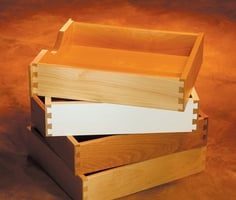Table of Contents 1. Introduction 2. Drawer Components 3. Types of Dovetail Joints 4. Pluses and...
Dovetail Spacing Specifications Developed to Give You Top-Quality Drawers
 At CCF, the quality of our dovetail joints is at the heart of everything we do. That’s why we thought that you would like to become familiar with the specifications related to how we make these attractive, sturdy features of drawers used in kitchens, bedrooms, closets, bathrooms, and home offices, as well as in hotels and other commercial buildings.
At CCF, the quality of our dovetail joints is at the heart of everything we do. That’s why we thought that you would like to become familiar with the specifications related to how we make these attractive, sturdy features of drawers used in kitchens, bedrooms, closets, bathrooms, and home offices, as well as in hotels and other commercial buildings.
We begin by cutting our joints with a 25 fixed-spindle dovetail machine spaced on 1” centers.
We then index all our drawers from the bottom edge because doing so helps us achieve the most precise center of the dovetail, which affects the amount of space from the top of the drawer to the top edge of the drawer’s joint.
The line drawings accompanying this text show you how the dovetails should be positioned based on the thickness of the drawer’s bottom material, as well as on the bottom recess.
On the drawings, you can see where the bottoms fit relative to the dovetail, based on the thickness of the bottom and the recess.
You will also notice that the drawings are marked even and odd. Those terms can help you determine the height of your drawer.
Even represents whole numbers such as 4”, 6”, and 8” while odd numbers represent fractional heights (mixed numbers) such as 4 ½”, 5 ¼”, and 6 3/8”.
To make sure you always get dovetail drawers that are visually appealing and fit your furniture and built-ins perfectly...






